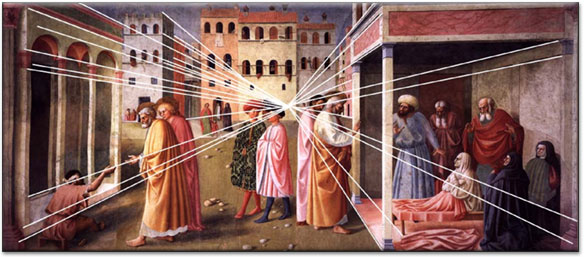|
The Rise of Renaissance Perspective

| |
|
|
Fig. 1. The one-point perspective construction, with convergence of the receding horizontals at the horizon. This construction applies only when the scene contains one set of parallel lines perpendicular to the picture plane and parallel to the ground. All other lines must be aligned with the picture plane.
|
ow well was perspective understood in the Renaissance? The conventional history is based on verbal accounts by Manetti (1480) and Vasari (1550), that it was first analyzed by the architect Filippo Brunelleschi (1377-1446) and demonstrated to his fellow Florentines in two dramatic peep-shows at some unspecified time between the years 1405 and 1425. Brunelleschi is frequently attributed with the knowledge of the one-point perspective construction and its introduction into Renaissance art. In fact, however, his peep-shows contained no one-point elements capable of supporting this construction and no paintings can be found with accurate one-point construction before the year 1423. (The peep-shows have not survived, but are described vividly by Manetti.) Moreover, the two-point construction of the peep-shows is virtually unknown throughout the Renaissance, seriously challenging the idea that Brunelleschi had a significant impact on the style of his fellow painters. Far from bursting full-fledged onto the Renaissance scene in the first quarter of the 15th century, a careful analysis of perspective styles reveals that understanding of the intricacies of perspective was reached only gradually over a period of 400 years. This survey focuses on one of its most accomplished exponents, Raffaello Sanzio (1483-1520), generally known as Raphael, and places his work in the context of other significant developments of the period.
| |
|
|
|
|
|
 |
|
|
|
Fig. 2. The lateral vanishing-point construction, illustrated on a perspective grid from Viator (1505). This construction suggests the perspective thinking that was being developed in Raphael’s time. Note the lack of need for any vanishing points in the construction, although the reconstruction lines show (almost) accurate adherence to both central and lateral vanishing points.
|
|
To evaluate perspective accuracy, one needs to have a clear understanding of the rules of perspective. Three of its rules will be relevance to the present discussion. One is the rule of the central vanishing point. If we imagine a canvas set up before the scene to be painted, all edges receding from the canvas (at a right angle to it) will project to lines in the picture converging toward a single, central vanishing point (Fig. 1). This is the familiar one-point construction, which applies to a scene where all other edges are parallel to the surface of the canvas. The second rule applies to other lines or edges at various angles in the ground plane, or parallel to the ground plane. All edges parallel to the ground plane will have a vanishing point at the same level as the central vanishing point. In fact, all these vanishing points will be in the line of the horizon. Particular examples of such lines are those connecting the corners of a square grid projected in perspective (Fig. 2). These obliques project to a lateral vanishing point in both directions that should align with the central vanishing point. Slight deviations from such alignment betray that the method of construction did not rely on such vanishing points, instead using the technique of a diagonal (solid line in original) crossing the converging orthogonals. Each intersection defines the correct position for a transversal break in the tiling, but small inaccuracies in the measurements show up as deviations at the long remove of the lateral projections.
 |
| Fig. 3. Masolino’s ‘St.
Peter Healing a Cripple and the Raising of Tabitha’ (1425). Note
the almost perfect convergence of the vanishing points for receding
horizontals from all parts of the composition, from the front of the
scene all the way to streets in the far distance. The occasional slips
seem attributable to lack of attention rather than lack of understanding
of the concept of the vanishing point.. |
 |
Although largely ignored in perspective histories, the central vanishing point appears to have been first used in 1423 by Masolino da Panicale (1383-c. 1440), and is well-illustrated by his painting from the same period of a double scene of miracles of St. Peter, which has a strong perspective construction (Fig. 3). Although the ground plane is rock-strewn earthen floor, almost all the receding horizontals in the buildings around the piazza conform accurately to a single vanishing point. This is the more remarkable because they span the visible depth from the front edge of the picture to the narrow streets in the far background (where the convergence requirements are close to parallel). Only someone with a thorough commitment to the principle of central convergence could have achieved this global level of uniformity. As shown in Fig. 3, one can find as many as 24 horizontals that converge to an accurate vanishing point, although 4 other lines deviate from this center by a small amount. As other early Quattrocento works show, the probability of finding this degree of convergence on the basis of intuitive construction alone is so small as to be negligible.
In the rest of the century following Masolino’s breakthrough, almost all Renaissance artists turned to the use of perspective to enhance their compositions, notably Masaccio, Mantegna, Fra Angelico and Leonardo. The Renaissance use of perspective reached its apogee at around 1500, as represented by the incandescent work of Raphael. In a career that paralleled that of Masolino, Raphael started his oeuvre painting Madonnas of unequalled grace and composure. Later in his short life (he died at 37),he produced some of the most imposing perspective compositions of the Renaissance, representing a kind of culmination of a century of perspective exploration.Unlike most of his predecessors, Raphael also included examples of the oblique perspective construction, leading one to ask whether he had finally achieved a full synthesis of the technique of linear projection that had become so commonplace.
< Previous Next > |
